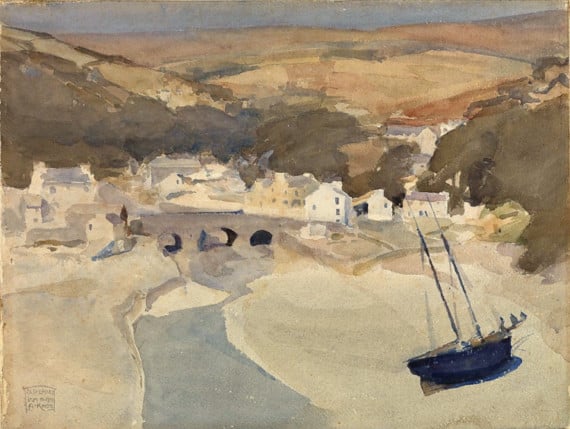Following on from her previous Buildings at Risk article, Patricia Newton of the Isle of Man Natural History and Antiquarian Society takes a look at the writings, sketches and watercolours that renowned Art Nouveau artist Archibald Knox produced of buildings in the Manx countryside and villages.
She shows that they provide a unique record of the island’s traditional, or vernacular, building styles and suggests that they could be used not only as the basis for a Blue Plaque Trail commemorating Knox’s island connections, but could also be used by Government to inform the building styles of today and to produce planning guidance for modern buildings that blend more comfortably with the island’s distinctive and beautiful landscape.
WITH disparagement from his engineer father but with the encouragement of his mother, the young Manx-born to Scottish parents Archibald Knox started sketching the buildings around him as a teenager.
Around 200 of these sketches are now in Manx National Heritage’s collection.
With many more hopefully surviving in private hands, these prove perhaps that, more than any other island artist, Knox recorded the built environment of his time.
In so doing, he provided the Manx nation with a unique record of the vernacular architecture of his era and indicated some of the architectural traits which were then, and perhaps now should again be, pre-eminent in considering a Manx architectural design of the future.
Knox had for his grammar school headmaster the Rev Canon John Quine, who became vicar of All Saints, Lonan.
Both were early and influential members of the Isle of Man Natural History and Antiquarian Society (IOMNHAS), which is now 140 years old and a promoter of the Alliance of Building Conservation which produces the Examiner’s Buildings at Risk articles.
One of Knox’s early papers was on St Adamnan’s/Keeil Traaie Old Kirk Lonan Church.
His description, published in the Antiquary 1898, shows that in sketching such buildings he noted in detail their context and surroundings. In the passage below Knox carefully analyses the evident two halves of the building and the order of their construction:
’The church is built in two parts which have their origins at different times.
’The eastern part is the older, and is greatly different in character of its structure from the western portion.
’The junction of the two buildings is very clear, for the walls are not bonded until four feet from the ground. This clean line of the junction represents probably the eastern jambs of doorways into the first church. The extended church as it is seen in plan, shows doubtless also the bed face.
’The doors in the north and south walls are bordered with dressed red sandstone brought from the western coast of Man.
’The stones are regularly cut and beautifully disposed in alternate wide and narrow arrangement. Some of the long stones are on their face three feet broad and six inches high, and alternate with stones six inches square.
’The jambs of the west window are gone, but their rests remain in the rubble wall.
’The eastern building is ruder. The sandstone is absent, but the walls and its angles have in it - not in consistent order - great stones four and five feet long. The stones throughout seen quarry stones, and are laid on their edge.’
How many of our historic or registered buildings are ever looked at in such detail by those who have the power to influence our future?
He also wrote a passage comparing the Nunnery chapel with St Adamnan’s ’through the little window on the southern wall - in size and position similar to the north wall in Lonan - a stream of light pours across the east end of the building.... It is a spectacle as living as words, and a perfect achievement of art.’
Whether or not the locations of his sketches are identified, small gable windows are a feature of many Manx rural buildings recorded by Knox.
Not only did they let in early morning or evening light but, under common law, no one could build a structure adjoining a gable window without the specific permission of the owner of the existing building - an early form of planning law!
Other features displayed in his art include the island’s earliest style of two-storey dwelling, with lintels of upstairs windows on the eaves line and the almost, but not totally, symmetrical frontage due to the thick walls of the internal chiollagh at one end.
Different styles of housing are illustrated, from the thatched cottage with the thatch carefully wrapped over the eaves of the building and roped and netted down to ’bwhid suggane’ (projecting stones for securing such ropes); to some upmarket farms with upturned V-shape pediment at the front, as at Upper Ballachrink, and cat-slide roof at the rear.
Dwelling forms vary: the extended farmhouse with its twin-peaked M gable roof profile, the barn attached to the dwelling house, and the conjoined dwellings of the farm manager’s house subservient to, but directly abutting, the landowner’s house.
In the sketch of one particular building, a further extension is attached to this - but on the ground had long since disappeared from the actual building. Knox’s sketch therefore enabled owners of this day and age to rebuild in accordance with the full extent of the former property at Knockaloe Beg.
Knox himself said: ’The farmhouses are the unadorned buildings ranged in some consistent and simple order.
’They are always of grey stone warm with bloom, for they are for the most part very old and present great spaces of wall broken by only very small windows. There are usually trees and a pool of water near these small homesteads, and the great circle of the waterwheel or the horse-circle of the threshing floor gives a touch of dignity to the simple forms.’
With such features vanishing rapidly where dwellings and farmsteads are renovated or redeveloped, should the importance of the remaining ones not be more formally recognised? Knox is doing us a favour by identifying the important characteristics, simple as they are, that make a building truly MANX.
What is the point of constructing a building on a high point where it gets the views but is open to the predominant rain-filled south-westerlies, or the ’Beasts from the East’?
Dwellings with all but their ridges below the level of the backing bank/ bank barns serve a purpose - they protect the dwelling from the worst of weather exposure.
They have roofs, sometimes hipped or shouldered, designed to break up the worst of the weather and, in the days before solar power, had their principal chimney stacks, within the context of thick, well-insulated walls, slightly higher than their opposing lesser chimney stacks.
More than in his pencil sketches, Knox’s watercolours generally record more of the setting of rural buildings and their response to slope.
One building is shown lying parallel to the contours and joined by an arch at right angles to a succession of buildings, their rooflines stepping down the slope.
In farming terms, this was providing a natural response to the need to obtain adequate gravitational drainage of the contents of the buildings, while in architectural terms it provided immense variety and interest, complementing the surrounding topography.
As regards island villages, Knox recorded the terraced housing of mill workers and the individual house which became the Railway Inn at Union Mills, and also the ’timber mill’ at Ballasalla. In his watercolours he showed that he appreciated, more than those in authority did, the setting of Old Laxey, with its bridge sitting comfortably in, and in sympathy with, its surroundings and the winding river below.
Uniquely among parish churches of Quine’s era, Knox designed the two war memorials and the mosaic floor in All Saints Lonan - a church that is not protected and which is now no longer permitted to be used regularly.
Weatherworn and dispersed in graveyards, Knox’s work can also be recognised in a number of headstones commemorating, amongst others, his mentors, friends, public heroes and victims of tragedy.
The subjects portrayed in many of Knox’s sketches have not been identified; does it matter?
Ideally many of the individual owners of these buildings would love to know that their property has been the subject of a Knox sketch and would probably agree to their being on a Knox blue plaque trail.
But that may be too much to ask.
However, in as much as these portraits of buildings represent the work of a now much-revered Manx artist and may be interpreted as giving a unique insight as to what is now worth recognising as prime features of Manx vernacular architecture - shouldn’t Government planning be giving cognisance to the fact?
Planning policy, in simplistic terms, allows for the conversion of proven, structurally stable buildings in the countryside into dwellings.
It promotes the renovation of [Unregistered] dwellings of architectural, historical and/or social interest and enables the demolition and replacement of habitable dwellings not falling into such categories by buildings which can have a 50 per cent increase in floorspace, excluding attics and basements. But there is no real control on design, or of the fit of resultant new dwellings into the landscape and climatic conditions rather than seeking to dominate them.
Planning Circular 3/91, Guide to the Design of Residential Development in the Countryside, is of limited use.
Original houses are submerged with ’wings’. Rather than a single gable end window or uneven distribution of gable windows, such homes are permitted to have four large, evenly-spaced ones.
Barns are converted by having large holes punched through for French windows or conservatories, rather than owners basing fenestration on the existing ’erratic’ distribution of openings. In addition, horsewalks are destroyed to enable construction of extensions.
New developments in the countryside should be looking to provide refined ways of reflecting the true traditional features of Manx style and materials, not providing large, blase pastiche.
But to ensure this, planners and architects need to comprehend Manx traditional style and materials and why they were used. Enter the wisdom derived from our island forebears that was recorded by Knox, his peers and their followers.
The introduction of, at the very least, a guide to a Blue Plaque Trail of Knox sketches and, in some cases, the recognition of the importance of the style of traditional Manx buildings themselves, could lead to their more formal designation in planning policy, either within Conservation Areas or some being designated as Registered Buildings. Such moves could be used to produce informed guidance creating a modern Manx vernacular style based on the criteria and an understanding of the old.
While living in Sulby, Knox wrote of his art that ’the places painted are within short walks from my home, passed often; one day something never seen before; some new appearance of colour and the bends of the sky.
’It may not be seen again; shortly it will fade and disappear, and in an hour forgotten. Such sights as they, as men over unimaginable centuries have looked at and learned to know their land is beautiful.’
One lives in hope that Manx people, planners and politicians will recognise what is worthy of retention: promoting and cherishing the traditional Manx built environment and its setting.
In the past the IOMNHAS designed commemorative medals based on Knox’s work. It is time to similarly promote a symbol in recognising places recorded by Knox.



.jpg?width=209&height=140&crop=209:145,smart&quality=75)

Comments
This article has no comments yet. Be the first to leave a comment.